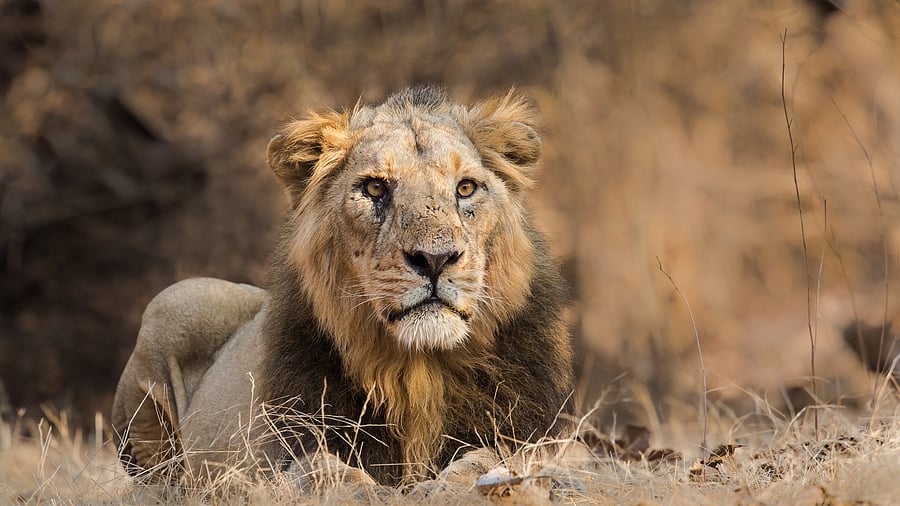
Representative image showing a male Asiatic lion
Credit: iStock Photo
Mushrooming of illegal tourist hotspots on private lands in Gir forest areas where lions are baited for outsiders is a key reason for nearly 25 lion attacks on humans in Gujarat every year, warn conservationists, flagging the need for policy measures to reverse the trend.
The Gir forest and surrounding areas have been attracting tourists for decades. As the only home for Asiatic lions, the Gir forest and surrounding areas have been attracting tourists for decades. With their numbers swelling, the animals are not always inside the parks; they roam around, often going outside the protected areas in search of prey. A group of conservationists and wildlife biologists has now shown that the locals also lured lions with bait so the tourists could glimpse the mighty beast and take pictures.
Their study reveals that areas of high lion conflict are near such hotspots and lion refuge patches, where the animals rest during the day. These spots are extended up to 10-15 km for livestock and human attacks.
“Baiting of lions is often practised at these community tourist hotspots. Such provisioning can cause lions to lose the fear of humans and impede the learning of hunting techniques in juvenile lions, resulting in adult lions becoming habituated to humans and losing their wild instincts. This can also artificially inflate lion densities, thereby creating more conflict,” they report in Conservation Biology.
“This practice of baiting also makes the lions more aggressive towards humans when they don’t get food because they depend on humans for food. Such behaviours are seen in Gir lions,” team leader Y V Jhala from the National Centre for Biological Sciences, Bengaluru, tells DH.
Jhala, who was formerly with the Wildlife Institute of India, Dehradun, and his teammates Keshab Gogoi, Kausik Banerjee, and Stotra Chakrabarti from WII and Anirudh Pratap Singh from the Gujarat forest department spoke to over 1,400 people in 277 villages and analysed 11,901 compensation claims to gain a better insight into human-lion interactions in the Gir and Saurashtra regions of Gujarat, which house an estimated 674 lions.
More than 62% of these lions are adults, 17% are sub-adults and 20% are cubs. The Gir forest houses the maximum number of lions (344), followed by Savarkundla (98), the southeastern coast (67), Girnar (56), and Bhavnagar (56). There are also a few lions on the southwestern coast (20), the Bhavnagar coast (17), and Mitiyala (16).
The lions have moved to forested patches through conducive corridors and are now distributed in nine districts of Saurashtra: Junagadh, Gir Somnath, Amreli, Bhavnagar, Botad, Porbandar, Jamnagar, Rajkot, and Surendranagar. These constituting 53 talukas cover a sprawling expanse of around 30,000 sq km, which is termed the Asiatic Lion landscape.
Due to an increase in lion numbers, livestock killings have increased by nearly 15% per year, and the number of villages where a lion attack has been registered has risen by close to 10%. The number of human attacks has remained more or less steady at around 25 per year over the last decade.
Although there has been no significant trend in human attacks by lions since 2012, scientists observed a slight peak in the summers, possibly because human activity often extends into cooler nights during summer months. Most attacks on humans are accidental or occur when lions are provoked. Rarely do lions consider humans prey, and those that do are promptly removed from the population by the park managers.
However, compared to three decades ago, the number of human attacks has increased. A 1994 study by a WII team reported around 15 lion attacks on humans every year between 1978 and 91. The difference is that earlier, the forest department staff used to bait inside the protected areas—a trend that has persisted until recently. Now, villagers living outside the forests do the same on their private land to earn extra money from tourists.
Jhala says the number of such villages may be in their twenties or thirties, and there is a need to bring them inside government-regulated lion tourism for better animal protection. However, the situation is challenging in Saurashtra because of the region’s complex demography.
There are communities like Maldhari that have lived with lions for over 150 years and people who have been living in protected areas for the last few decades. Lions kill feral cattle and agricultural pests like wild pigs and nilgai, and the farming community appreciates their services. A section of the population is associated with the government-promoted lion tourism, but many are outside. The level of education also plays a key role in determining people’s attitudes towards lions.
In villages with illegal tourist hotspots, the researchers suspect that most compensation claims for livestock are for animals used as bait. “It seems that compensation is often claimed in these villages for livestock that might have been offered as bait to lions at these community tourist hotspots. The currently illegal practice of lion tourism at such hotspots seems to be thus subsidised through public funds,” they report.
Jhala says legitimising such hotspots under the Wildlife Protection Act, 1972 and putting them under government control is the way forward as that will stop such wrongful practices and allow locals to get a share of the revenue. “Our results highlight the economic benefits for communities coexisting with lions as a key factor in promoting tolerance. Institutionalising lion-based ecotourism on community lands could support coexistence in the long term,” he adds.
